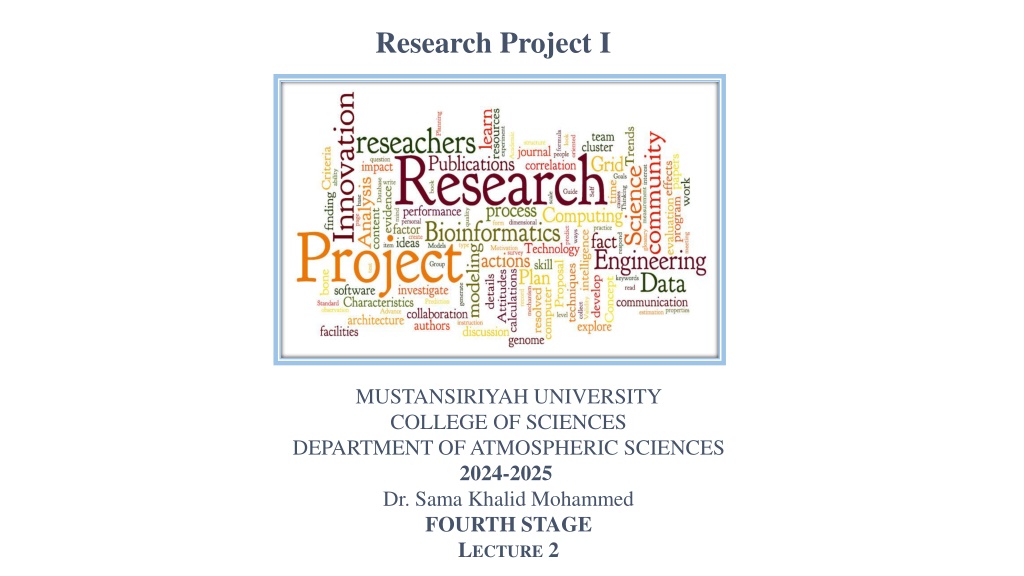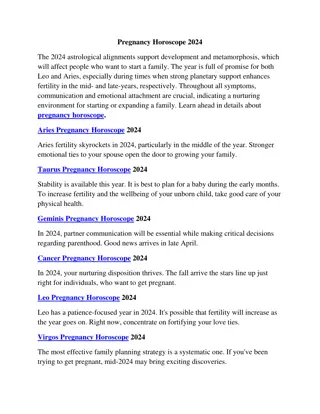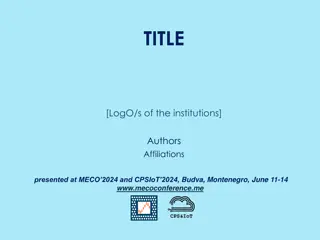
Effective Strategies for Background Research in Atmospheric Sciences
Learn how to narrow down research topics effectively, categorize sources of information, and differentiate between quantitative and qualitative data in the field of atmospheric sciences. Discover the importance of finding specific research questions to guide your study efficiently.
Download Presentation

Please find below an Image/Link to download the presentation.
The content on the website is provided AS IS for your information and personal use only. It may not be sold, licensed, or shared on other websites without obtaining consent from the author. Download presentation by click this link. If you encounter any issues during the download, it is possible that the publisher has removed the file from their server.
E N D
Presentation Transcript
Research Project I MUSTANSIRIYAH UNIVERSITY COLLEGE OF SCIENCES DEPARTMENT OF ATMOSPHERIC SCIENCES 2024-2025 Dr. Sama Khalid Mohammed FOURTH STAGE LECTURE 2
Lecture Outline Continue to Do Background Research. Finding Information. How to narrow your search? Categorizing Sources of Information(Quantitative or Qualitative, Fact or Opinion, Objective and Subjective, Primary, Secondary & Tertiary Sources). Publication Formats and the Information Lifecycle (Books, Newspapers, Web sites, Articles, Conference Papers, Blogs, Documentaries, Online Videos, Podcasts, Scholarly Articles as Sources (Peer-Reviewed Sources) & Step-by-Step Instructions for Reading a Primary Research Article).
2. Do Background Research Finding Information How to narrow your search? All Possible Topics You ll need to narrow your topic in order to do research effectively. Without specific areas of focus, it will be hard to even know where to begin (ex. Atmospheric Physics ) Assigned Topics a narrower topic boils down to deciding what s interesting to you. One way to get ideas is to read background information in a source like Wikipedia (ex. Aerosols and clouds) Topic Narrowed by Initial Exploration It s wise to do some more reading about that narrower topic to a) learn more about it and b) learn specialized terms used by professionals and scholars who study it ( cloud condensation nuclei CCN) Topic Narrowed to Research Question(s) A research question defines exactly what you are trying to find out. It will influence most of the steps you take to conduct the research ( how does dust serves as CCN?)
2. Do Background Research Finding Information Categorizing Sources of Information A source can be categorized by: Whether it contains quantitative or qualitative information or both Whether the source is objective (factual) or persuasive (opinion) and may be biased ) ( ) ( Whether the source is a scholarly, professional or popular publication Whether the material is a primary, secondary or tertiary source What format the source is in Understanding types of sources helps guide your search
2. Do Background Research Finding Information Quantitative or Qualitative Quantitative Information Involves a measurable quantity numbers are used. Some examples are length, mass, temperature, and time. Quantitative information is often called data, but can also be things other than numbers. Qualitative Information Involves a descriptive judgment instead of numbers. Gender, country name, animal species, and emotional state are examples of qualitative information. using concept words
2. Do Background Research Finding Information Quantitative or Qualitative
2. Do Background Research Finding Information Fact or Opinion Thinking about the reason an author produced a source can be helpful to you because that reason was what dictated the kind of information he/she chose to include. Depending on that purpose, the author may have chosen to include factual, analytical, and objective information. Or, instead, it may have suited his/her purpose to include information that was subjective and therefore less factual and analytical. Fact Facts are useful to inform or make an argument The United States was established in 1776. The pH levels in acids are lower than pH levels in alkalines. Opinion Opinions are useful to persuade ) and demand evidence to back them up. Examples: That was a good movie. Strawberries taste better blueberries. . Examples: ) ( , but careful readers and listeners will notice (
2. Do Background Research Finding Information Objective and Subjective Objective Objective information reflects a research finding or multiple perspectives that are not biased. Examples: Several studies show that an active lifestyle reduces the risk of heart disease and diabetes. Studies from the Brown University Medical School show that twenty-somethings eat 25 percent more fast-food meals at this age than they did as teenagers. Subjective Subjective information presents one person or organization s perspective or interpretation. Subjective information can be meant to distort , or it can reflect educated and informed thinking. All opinions are subjective, but some are backed up with facts more than others. Examples: The simple truth is this: As human beings, we were meant to move.
2. Do Background Research Finding Information Objective and Subjective In their thirties, women should stock up on calcium to ensure strong, dense bones and toward off osteoporosis later in life. * *In this quote, it s mostly the should that makes it subjective. The objective version of the last quote would read: Studies have shown that women who begin taking calcium in their 30s show stronger bone density than women who did not take calcium at all. But perhaps there are other data showing complications from taking calcium. That s why drawing the conclusion that requires a should makes the statement subjective.
2. Do Background Research Finding Information Primary, Secondary & Tertiary Sources Another information category is called publication mode and has to do with whether the information is Firsthand information (information in its original form, not translated or published in another form). Secondhand information (a restatement, analysis, or interpretation of original information). Third-hand information (a summary or repackaging of original information, often based on secondary information that has been published).
2. Do Background Research Finding Information Primary, Secondary & Tertiary Sources Primary Sources Because it is in its original form, the information in primary sources has reached us from its creators without going through any filter. We get it firsthand. Here are some examples that are often used as primary sources: Scholarly blogs that provide data or are highly theoretical, even though they contain no autobiography. Websites, although many are secondary. Buildings. Correspondence, including email. Records of organizations and government agencies. Journal articles that report research for the first time (at least the parts about the new research, plus their data). Breaking news. Diaries. Eyewitness accounts, including photographs and recorded interviews. Data. Blog entries that are autobiographical.
2. Do Background Research Finding Information Primary, Secondary & Tertiary Sources Secondary Source These sources are translated, repackaged, restated, analyzed, or interpreted original information that is a primary source. Thus, the information comes to us secondhand, or through at least one filter. Here are some examples that are often used as secondary sources: All nonfiction books and magazine articles except autobiography. An article or web site that collect expert opinion and several eyewitness accounts for a new understanding of an event. The literature review portion of a journal article.
2. Do Background Research Finding Information Primary, Secondary & Tertiary Sources Tertiary Source These sources further repackage the original information because they index , condense , or summarize the original. Typically, by the time tertiary sources are developed, there have been many secondary sources prepared on their subjects, and you can think of tertiary sources as information that comes to us third-hand. Tertiary sources are usually publications that you are not intended to read from cover to cover but to dip in and out of for the information you need. You can think of them as a good place for background information to start your research but a bad place to end up.
2. Do Background Research Finding Information Primary, Secondary & Tertiary Sources Here are some examples that are often used as tertiary sources: Dictionaries. Guide books. Survey articles. Timelines . Bibliographies . Encyclopedias, including Wikipedia. Most textbooks Tertiary sources are usually not acceptable as cited sources in college research projects because they are so far from firsthand information. That s why most professors don t want you to use Wikipedia as a citable source: the information in Wikipedia is far from original information. Other people have considered it, decided what they think about it, rearranged it, and summarized it all of which is actually what your professors want you, not another author, to do with information in your research projects.
2. Do Background Research Finding Information Publication Formats and the Information Lifecycle Books: Published at one time and requiring great effort on the part of the author and a publisher. Magazines/Journals Published frequently, containing lots of articles related to some general or specific professional research interest; edited. Newspapers: Each is usually a daily publication of events of social, political and lifestyle interest. Web sites: Digital items, each consisting of multiple pages produced by someone with technical skills or the ability to pay someone with technical skills.
2. Do Background Research Finding Information Publication Formats and the Information Lifecycle Articles: Short, written pieces that might contain photos and are generally timely. Conference Papers: Written form of papers delivered at a professional or research-related conference. Authors are generally practicing professionals or scholars in the field. Blogs: Frequently updated websites that do not necessarily require extensive technical skills and can be published by virtually anyone for no cost to themselves other than the time they devote to content creation. Usually marked by postings that indicate the date when each was written.
2. Do Background Research Finding Information Publication Formats and the Information Lifecycle Documentaries: Works, such as a film or television program, presenting political, social, or historical subject matter in a factual and informative manner and often consisting of actual news films or interviews accompanied by narration. Online Videos: Short videos produced by anybody, with a lot of money or a little money, about anything for the world to see. Common sites for these are YouTube and Vimeo. Podcasts : Digital audio files, produced by anyone and about anything, that are available for downloading, often by subscription.
2. Do Background Research Finding Information Scholarly Articles as Sources Articles in scholarly journals are valued for several reasons: 1. they are usually trustworthy because their publication process includes a peer review their accuracy and contribution to their disciplines . 2. they often contain the first reports of new research, which makes their sections on methodology, data, analysis, and interpretation primary sources. 3. Sometimes they instead consist of literature reviews summaries of multiple research studies done in the past on particular subjects of current interest. That makes those articles very helpful secondary sources. that helps insure
2. Do Background Research Finding Information Peer-Reviewed Sources The most-respected scholarly journals are peer-reviewed, which means that experts in their field other than the author and editor check out each article before it can be published. It s their responsibility to help guarantee that new material is presented in the context of what is already known, that the methods the researcher used are the right ones, and that the article contributes to the field. For those reasons, peer-reviewed articles are more likely to be credible. Peer-reviewed journal articles are the official scholarly record, which means that if it s an important development in research, it will probably turn up in a journal article eventually .






















